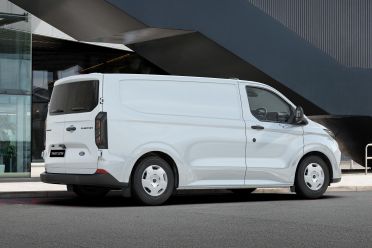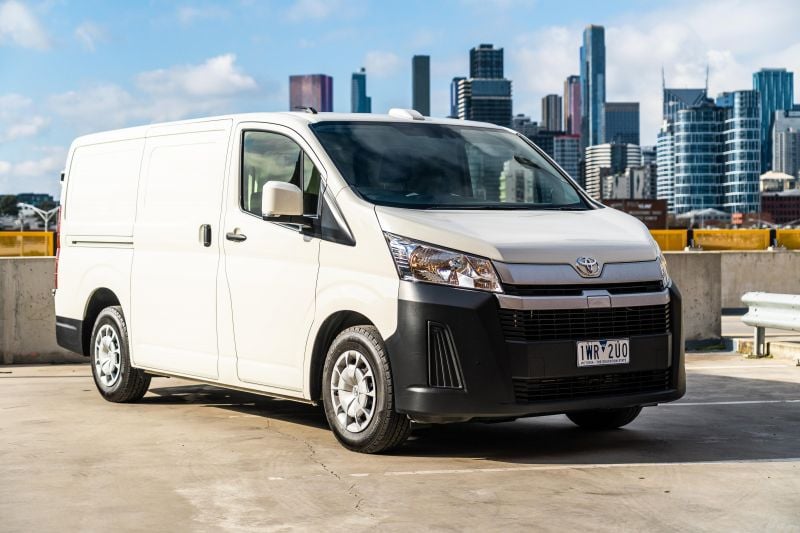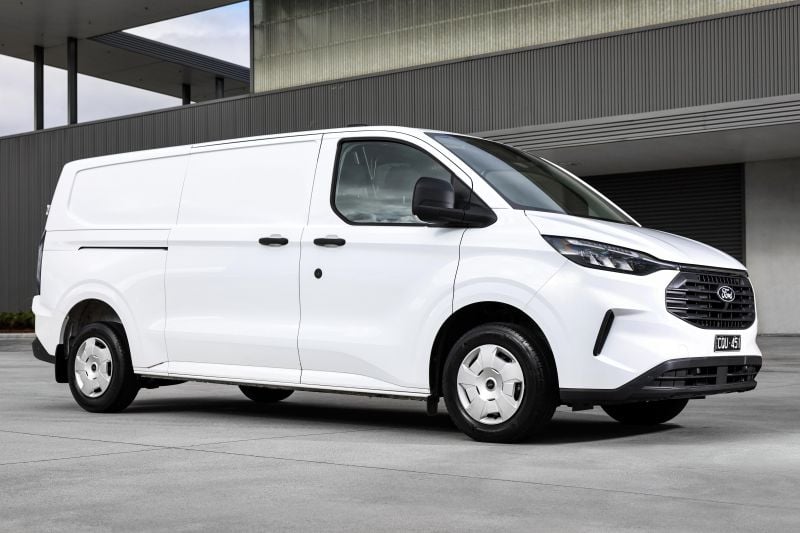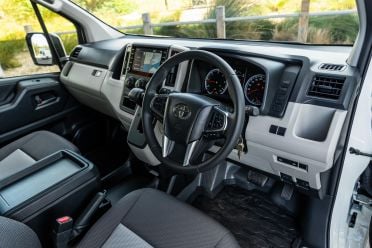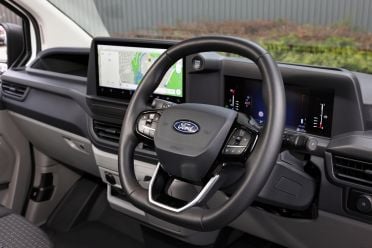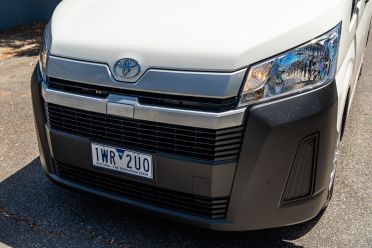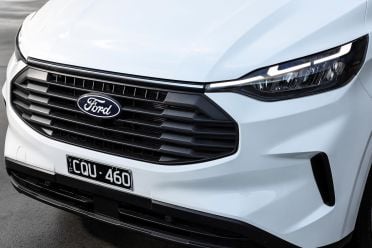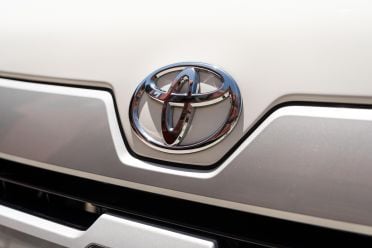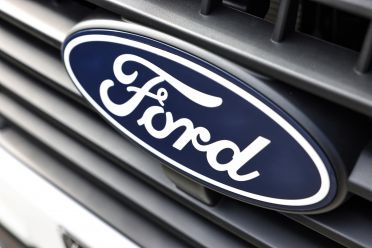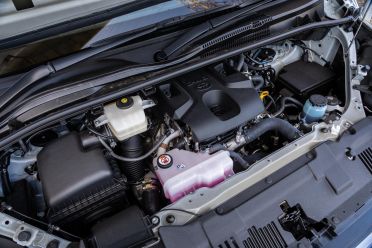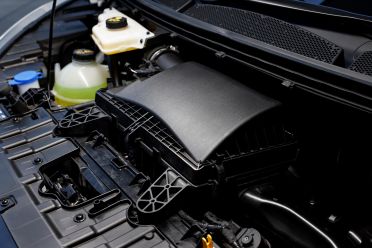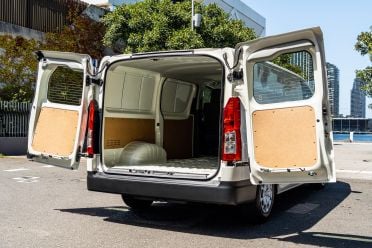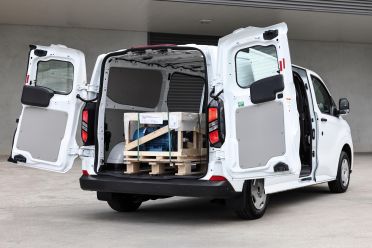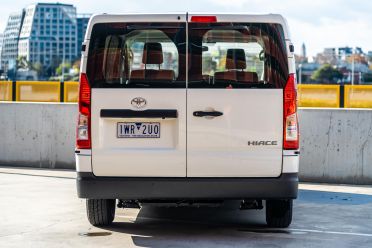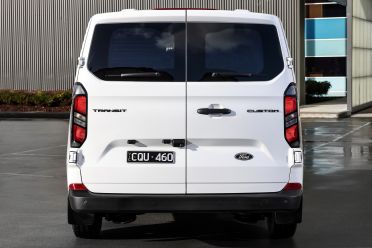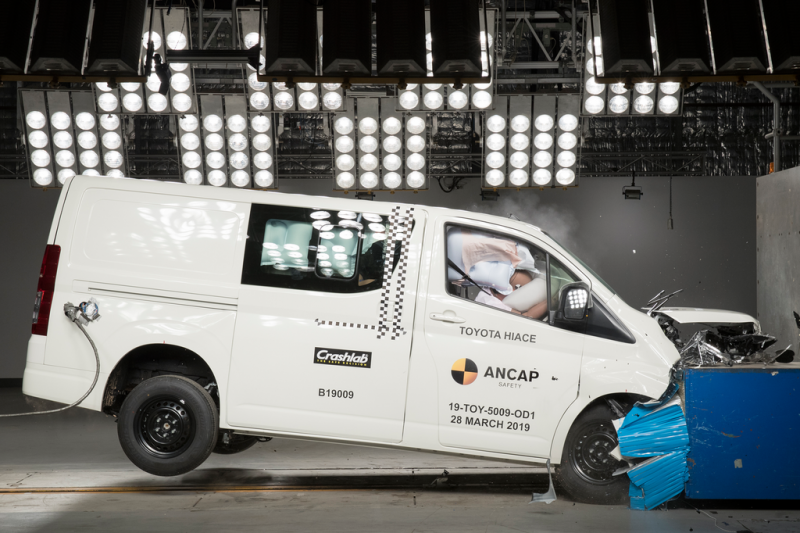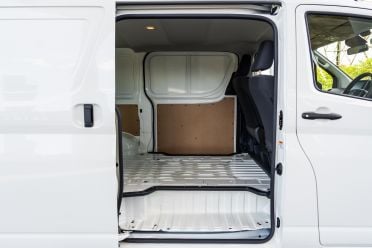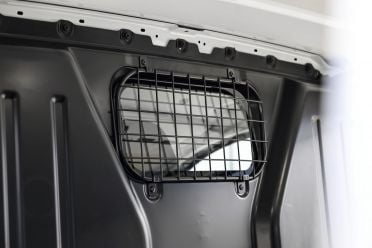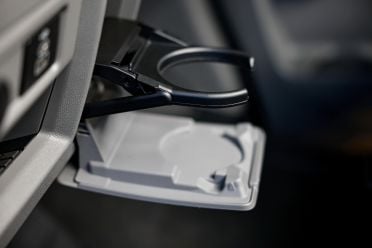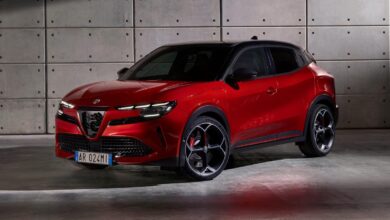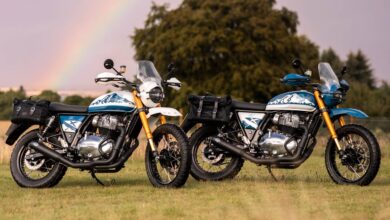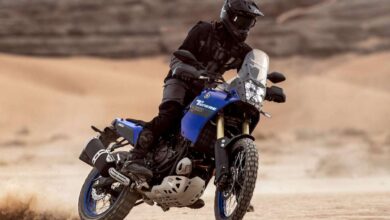Toyota HiAce v Ford Transit Custom comparison
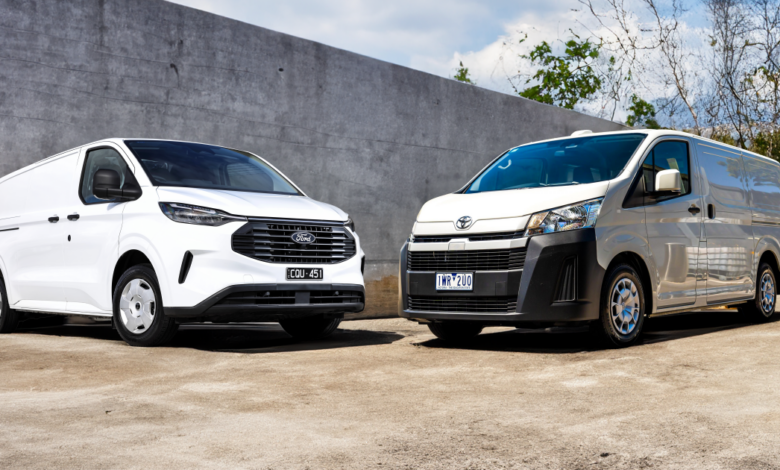
There are a number of vans on sale in Australia, but chances two names that stand out to the average buyer above the rest.
They’re van heavy-hitters from Toyota and Ford, and they’re the HiAce and Transit Custom. Both have existed for some time and share the vans from 2.5-tonne to 3.5-tonne VFACTS segment, though the HiAce continues to dominate the sales charts.
In 2023 there were 7133 total HiAce vans sold, compared to Ford’s figures of 2843 Transit Custom sales. The Transit Custom wasn’t even the second-highest seller; that honour went to the LDV G10 with 3638.
Still, the Transit Custom just received a major update and is now the result of a partnership between Ford and Volkswagen – the same duo that gave us the Ranger and Amarok cousins. That should be a recipe for a winning van, but there’s still a mountain to climb before it can reach the heights of the HiAce.
For a start, the HiAce undercuts the Transit Custom in price. At $48,886 before on-roads, its cheapest version is noticeably cheaper than the base Ford, which is priced at $55,990 before on-roads.
With the Toyota you also get a diesel powertrain which offers higher power and torque figures than the Ford, while maintaining a commendable fuel economy claim.
It also received a minor update this year, which added wireless smartphone mirroring among various other tweaks. The HiAce can cover a wide range of bases as well, as it’s offered as a basic commercial van, Crew Van, and large Commuter bus.
In the blue corner is the Transit Custom, which while more expensive offers loads of tech in its latest iteration.
Standard features include wireless smartphone mirroring and large high-quality displays, and it has a larger quoted cargo capacity than the HiAce. A wireless phone charger is standard, as is – for the first time in a Ford in Australia – a 5G embedded modem.
The transmission shifter has been moved to the column and there’s now an electric parking brake, allowing the driver to enter easily from either side and go into the back without incident.
Ford also says it has increased space up front by moving the front wheels and strut towers further forward, while the Transit Custom has a shorter front overhang and is lighter than its predecessor. There are of course other versions of Ford’s van, namely the larger Transit.
Going under the microscope here are the cheapest Barn Door HiAce and the cheapest long-wheelbase Ford Transit Custom. While they’re not identical on price, both are a solid representation of what both lineups have to offer.
Both are also fitted with barn doors at the rear, with no side windows included behind the front compartment. They each also offer a range of safety gear and standard equipment, even if the current HiAce is now getting on in years.
A key difference in the standard Transit Custom is its cargo bay protection, which includes a metal bulkhead to isolate the front seats. No such features are offered as standard in the HiAce; you’ll instead have to purchase them as one of the many additional extras available.
Here’s how the two models stack up on the spec sheet.
Interested in a Toyota HiAce or a Ford Transit Custom? CarExpert’s specialists can help you find a deal.
Pricing
The Toyota HiAce LWB Barn Door is the cheapest barn door HiAce you can get, and it received a small price bump in the past year. It’s now priced at $50,886 before on-roads.
The Transit Custom Trend LWB sits second from the bottom of its range and will set you back $56,990 before on-roads. It’s exactly $1000 more expensive than the short-wheelbase Trend, and stepping up to a more expensive version will take you the Sport SWB at just under $60,000.
The latest generation brings a base price increase of $5800 over the outgoing cheapest version, which was first revealed in 2012.
| Model | Price before on-roads |
|---|---|
| 2024 Toyota HiAce LWB Barn Door | $50,886 |
| 2024 Ford Transit Custom Trend LWB | $56,990 |
Interested in a Toyota HiAce or a Ford Transit Custom? CarExpert’s specialists can help you find a deal.
Drivetrains and efficiency
Both vans offer one engine across their respective lineups, and they’re both turbo-diesel units mated with automatic transmissions.
While the Transit Custom is automatic-only, you can still get a six-speed manual transmission in the HiAce – but only at the very bottom of the range.
The HiAce has a larger displacement, though power figures on paper don’t differ massively between the two. Key differences are found with the drivetrains of each van, as the Toyota comes standard with a six-speed transmission compared to the Ford’s eight-speed unit.
Power in the HiAce is sent to the rear wheels exclusively, while the Transit Custom is front-wheel drive only.
Both still have nearly identical fuel economy claims and drink from 70-litre tanks, though the Transit Custom adds a 20-litre AdBlue tank.
| Toyota HiAce LWB Barn Door | Ford Transit Custom Trend LWB | |
|---|---|---|
| Engine | 2.8L 4cyl turbo-diesel | 2.0L 4cyl turbo-diesel |
| Power | 130kW @ 3400rpm | 125kW @ 3500rpm |
| Torque | 450Nm @ 1600-2400rpm | 390Nm @ 1750-2500rpm |
| Transmission | 6-speed automatic | 8-speed automatic |
| Driven wheels | Rear-wheel drive | Front-wheel drive |
| Fuel economy (claimed) | 7.9L/100km | 8.0L/100km |
| Fuel tank capacity | 70L | 70L (+20L AdBlue) |
| CO₂ (combined) | 197g/km | 209g/km |
Interested in a Toyota HiAce or a Ford Transit Custom? CarExpert’s specialists can help you find a deal.
Dimensions
The new Transit Custom is larger than the HiAce in almost every metric.
It’s roughly 200mm longer and wider with its mirrors folded, as Toyota doesn’t quote a vehicle with that includes the mirrors. It rides on a wheelbase that’s nearly 300mm longer, and it’s only marginally shorter in height but doesn’t compromise cargo space.
The Transit Custom has a larger cargo volume than the HiAce, measured in a bay that’s longer, wider, and taller than the Toyota. Ford doesn’t quote a maximum cargo area width, though the measurement between the wheel arches is more than 100mm in its favour.
Both vehicles measure similarly on weigh-in, though the Transit Custom has a braked towing capacity that’s 1000kg heavier than the HiAce.
| Dimensions | Toyota HiAce LWB Barn Door | Ford Transit Custom Trend LWB |
|---|---|---|
| Length | 5265mm | 5450mm |
| Width | 1950mm (excl. mirrors) | 2275mm (2148mm mirrors folded) |
| Height | 1990mm | 1980mm |
| Wheelbase | 3210mm | 3500mm |
| Cargo bay length | 2530mm | 3002mm |
| Cargo bay width | 1268mm (between wheel arches) 1760mm (total) |
1392mm (between wheel arches) |
| Cargo bay height | 1340mm | 1425mm |
| Cargo bay volume | 6.2m3 | 6.8m3 |
| Payload | 1075kg | 1014kg |
| Kerb weight | 2200kg | 2211kg |
| Gross Vehicle Mass (GVM) | 3300kg | 3225kg |
| Gross Combination Mass (GCM) | 4800kg | 5725kg |
| Towing capacity | 1500kg (braked) | 2500kg (braked) |
Interested in a Toyota HiAce or a Ford Transit Custom? CarExpert’s specialists can help you find a deal.
Servicing and warranty
Both vans are covered by a standard five-year, unlimited-kilometre warranty.
The main difference between the two is service intervals, which are shorter on the HiAce. With servicing required every six months or 10,000km, you’ll be spending more time at the mechanic than in the Ford.
Service prices are capped at $260 for the first six visits with the HiAce, while Ford only offers capped-price servicing for the first four visits at $499 each.
Toyota also doesn’t offer roadside assist as standard with new HiAce purchases, contrasting Ford’s new car roadside assist deal that gets extended every time you service the Transit Custom at Ford.
| Running costs | Toyota HiAce LWB Barn Door | Ford Transit Custom Trend LWB |
|---|---|---|
| Warranty | 5 years, unlimited kilometres | 5 years, unlimited kilometres |
| Service interval | 6 months, 10,000km | 12 months, 30,000km |
| Capped price servicing | First 6 visits, $260 each | First 4 visits, $499 each |
| Total capped price cost | $1560 | $1996 |
| Roadside assist | Paid | From purchase, then service-activated |
Interested in a Toyota HiAce or a Ford Transit Custom? CarExpert’s specialists can help you find a deal.
Safety
The Toyota HiAce wears a five-star ANCAP safety rating based on testing conducted in 2019.
In contrast, the new Transit Custom is yet to be tested by ANCAP, and is therefore unrated.
Here’s a breakdown of standard safety equipment on each van:
| Safety feature | Toyota HiAce LWB Barn Door | Ford Transit Custom Trend LWB |
|---|---|---|
| Airbags | 7 | 6 |
| Autonomous emergency braking (AEB) | Yes (pedestrian, daylight cyclist) | Yes (junction assist, reverse) |
| Lane-keep assist | Lane departure alert, braking | Yes (with lane departure alert) |
| Blind-spot monitoring | Yes (with assist) | Yes (with assist) |
| Adaptive cruise control | No | Yes |
| Traffic sign recognition | Yes (speed only) | Yes |
| Reversing camera | Yes | Yes |
| Surround-view camera | No | 180-degree |
| Rear cross-traffic alert | Yes | Yes |
| Parking sensors | Yes (front and rear) | Yes (front and rear) |
| Park assist | No | No |
| Tyre pressure monitoring | No | Yes |
| Driver monitoring | No | Yes |
| Safe exit warning | No | Yes |
| Automatic high-beam | Yes | Yes |
While there aren’t any safety features to be added to the HiAce, Toyota Connected Services includes safety and security tech including stolen vehicle tracking, automatic collision notification, and SOS emergency call.
The Transit Custom packs in more safety tech like adaptive cruise control, driver monitoring, safe exit warning, and a 180-degree function with its reversing camera, though it does include one fewer airbag as standard.
Here’s a breakdown of each car’s safety scoring:
| Assessment | Toyota HiAce LWB Barn Door | Ford Transit Custom Trend LWB |
|---|---|---|
| Adult occupant protection | 35.8 out of 38 (94 per cent) | – |
| Child occupant protection | 43.3 out of 49 (88 per cent) | – |
| Vulnerable road user protection | 40.6 out of 48 (84 per cent) | – |
| Safety assist | 10.1 out of 13 (77 per cent) | – |
Interested in a Toyota HiAce or a Ford Transit Custom? CarExpert’s specialists can help you find a deal.
Standard features
These vans share many similar features, though there are some key difference that set them apart.
| Exterior | Toyota HiAce LWB Barn Door | Ford Transit Custom Trend LWB |
|---|---|---|
| Wheels | 16-inch steel | 16-inch steel |
| Spare wheel | Full-size | Full-size |
| Headlights | Halogen | Halogen, dusk-sensing |
| Fog lights | No | Rear only |
| Wipers | Standard | Rain-sensing, heated windscreen |
| Side mirrors | Standard | Standard (with fisheye extension) |
| Sunroof | No | No |
| Tailgate | Barn door | Barn door |
The main exterior differences are to do with tech. The Transit Custom packs dusk-sensing headlights, rain-sensing wipers, and a heated windscreen over the HiAce as standard.
The side mirrors are fitted with a fisheye section to help see a wider angle. Ford has also included fog lights on its van, but only on the rear.
Both vans offer barn doors at the rear, alongside the same size wheels and halogen headlights instead of LEDs.
| Interior | Toyota HiAce LWB Barn Door | Ford Transit Custom Trend LWB |
|---|---|---|
| Upholstery | Cloth | Cloth |
| Front seats | Powered driver’s lumbar | Heated, three-seat 8-way manual driver adjustment with armrest |
| Rear seats | – | Metal bulkhead |
| Cargo bay | 6 tie-down hoops Wood wall panelling |
8 tie-down hoops Protection kit (walls, floor) |
| Steering wheel | Leather-accented | Leatherette-wrapped |
| Gear selector | Central, plastic | Steering column stalk |
| Paddle shifters | No | No |
| Rear-view mirror | Standard | Standard |
| Climate control | Single-zone | Single-zone |
Contrasting the HiAce, the Transit Custom offers three seats in the front row. It’s arranged in a dual-passenger, single-driver setup, with the latter treated to a single armrest and eight-way manual adjustment that includes lumbar support. All three feature a heating function.
The gear selector is also a key difference, as this latest generation of Transit Custom has relocated it to a stalk on the right of the steering column, instead of the more conventional central arrangement seen in the HiAce.
Behind the front seats are where cargo is stored, as the Transit Custom is fitted with a metal bulkhead and cargo bay protection as standard. There’s also a pass-through underneath the outboard passenger seat, creating capacity for longer items.
The HiAce can also be fitted with an isolating bulkhead and cargo bay protection, though buyers must select it as an optional extra.
| Technology | Toyota HiAce LWB Barn Door | Ford Transit Custom Trend LWB |
|---|---|---|
| Instrument cluster | 4.2-inch multi-information display | 7.0-inch screen |
| Head-up display | No | No |
| Infotainment | 8.0-inch touchscreen | 13.0-inch touchscreen |
| Satellite navigation | Yes | Yes |
| Smartphone mirroring | Wireless Apple CarPlay and Android Auto | Wireless Apple CarPlay and Android Auto |
| Phone charging | USB-A | Wireless charging pad |
| USB | 1 front USB-A | 1 front USB-A, 1 front USB-C |
| Sound system | 2-speaker | 4-speaker |
| Key | Keyless start | Keyless start |
| Connectivity | Toyota Connected Services | FordPass app 5G embedded modem |
There are more tech differences on the inside, namely in display setups. The newer Transit Custom boasts larger screens and more speakers, as well as an Australia-first 5G embedded modem.
Both now have wireless smartphone mirroring and minimal USB connectivity, though Ford has included a wireless phone charger in its new Transit Custom as a bonus over the HiAce
Both also include arrangements for their manufacturer’s connected services platforms, which both include app connectivity and a suite of other bonuses – particularly for Toyota
Interested in a Toyota HiAce or a Ford Transit Custom? CarExpert’s specialists can help you find a deal.
Options
Though some are treated as separate variants, most of the additions to the standard LWB van are technically optional extras in the Toyota configurator.
Here’s a breakdown of the options available to automatic LWB HiAce vans only:
Option 1: Panel pack (automatic only)
- Left sliding door with steel panel
Option 2: 4-door pack
- 4-door option with left sliding door
Option 3: GL Pack ($3000)
- Painted front and rear bumpers
- Painted door handles
- Front and rear chrome garnish
- Digital rear view mirror with auto-dimming
- Fog lamps
Toyota also offers a range of genuine accessories, including:
- Roof racks
- Tow bar
- Tow ball
- Trailer wiring harness
- Rear corner protectors
- Interior ladder rack
- Interior panel protectors
- Rear technician step
- Front nudge bar
- Canvas seat covers
- All-weather cargo liner
- Side window weather shield
- Air conditioning partition (not applicable to 4-door variant)
- Cargo barrier fence – front position
- Solid partition barrier
There aren’t as many options for the Transit Custom, but you can still add some extras on to suit your needs.
The following options are available on the Trend:
Dual side load doors with no windows ($1000)
Secure Visibility Pack ($1500)
- Steel rear doors
- Digital rear-view mirror with integrated dashcam
- Windowless metal bulkhead
Load Space Air Conditioning ($700)
Which would be your pick? Let us know in the comments.
Interested in a Toyota HiAce or a Ford Transit Custom? CarExpert’s specialists can help you find a deal.
BUY: Get in touch with a dealer about a Toyota HiAce
MORE: Everything Toyota HiAce
BUY: Get in touch with a dealer about a Ford Transit Custom
MORE: Everything Ford Transit Custom

